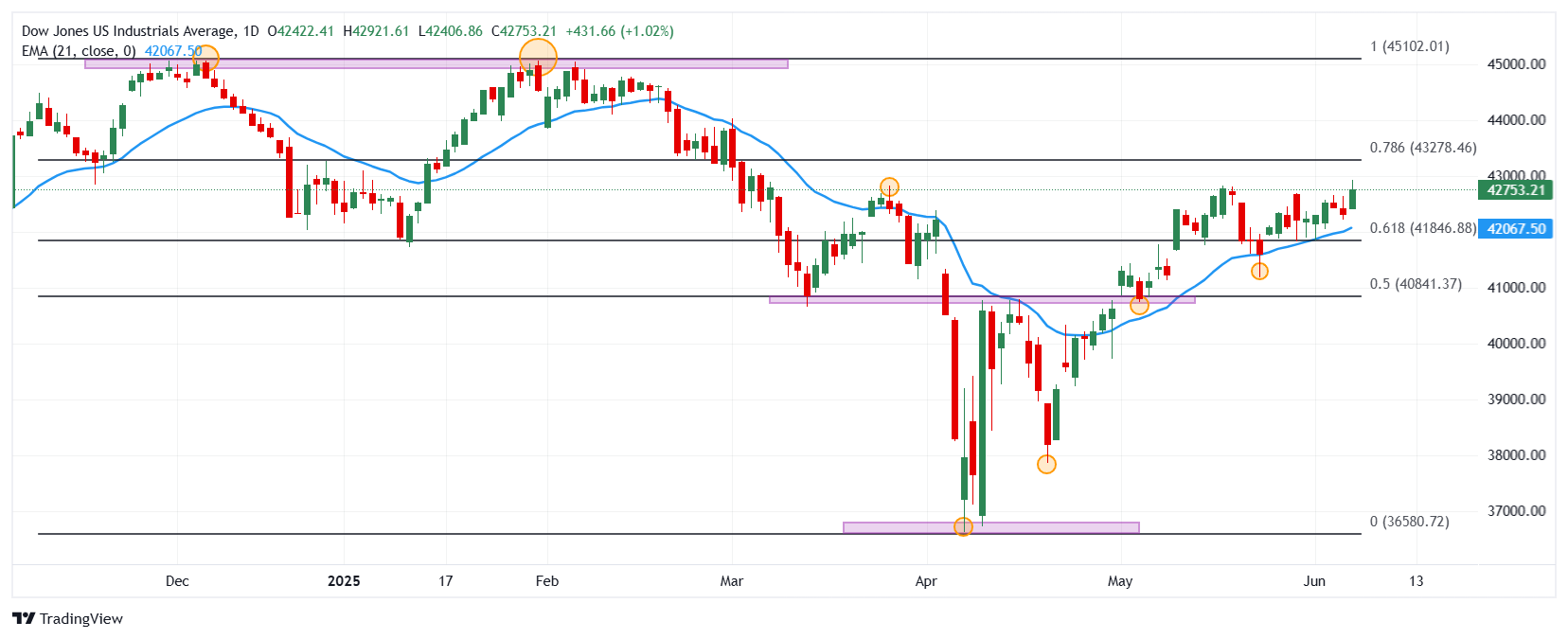- The Dow Jones rises 1.02% today, reaching maximums not seen since March 6 in 42,921.
- The Nasdaq 100 rebounded 1.02% daily, oscillating within the range of the previous session at 21,765.
- The S&P 500 wins 1.04% on Friday, driven by Palantir Technologies (PLT).
- Non -agricultural payrolls increase to 139,000 in May, overcoming analysts’ estimates.
- Patrick Harker, president of the Fed of Philadelphia, showed his concern for the current state of government finances.
The Dow Jones marked a minimum of the day in 42,406, opening buyers who promoted the index to maximums not seen since March 6 in 42,921, ending with two consecutive days down.
The Dow Jones industrial average began operating at 42,422, while the Nasdaq 100 technological index began negotiations in 21,571. The S&P 500 opened in 5,952, taking up the upward trend until reaching maximums of February 24 in 6,014.
Salesforce and Amazon drive Dow Jones to two months
The Dow Jones index advances 1.02%, reaching maximums of March 6 in 42,921.
Amazon titles (AMZN) earn 2.72% on Friday, reaching May 13 in 213.87 $, signing three consecutive sessions with profits.
Following the upward perspective, the Salesforce (CRM) values, gain 2.76% daily, visiting maximum of May 28 in 274.90, leading the profits in the stock market index.
In this scenario, Dow Jones advances 431 points in the last session of the week, operating at the time of writing about 42,753.
The Nasdaq 100 operates in positive terrain led by Palantir Technologies and Shopify
The Nasdaq 100 technological index rises 0.93% today consolidating within the operating range of June 5 at 21,749.
Palantir Technologies (PLT) values advance 6.56%, staying within the operational range of the previous session at $ 127,72, ending with two consecutive days down.
In the same tune, Shopify shares (Shop) earn 6.07% in the day, visiting May 16 at $ 112.08, spinning two consecutive upward sessions.
The Nasdaq 100 rebounded 200 points, reaching a maximum of the day in 21833, taking up the upward trend in tune with the main stock market indices.
The S&P 500 reaches maximums of more than three months after the publication of non -agricultural payrolls in the United States
Based on information provided by the United States Department of Labor, May non -agricultural payrolls increased to 139,000, exceeding 130,000 estimated and 147,000 observed in the previous month.
On the other hand, the United States unemployment rate was 4.2% in the same period, complying with the previous and planned 4.2%.
In another front, the president of the Federal Reserve of Philadelphia, Patrick Harker, said that commercial uncertainty makes it very difficult to foresee the perspective of monetary policy. Similarly, he showed his concern for the current state of government finances, noting that deficits should be controlled to deal with the challenges of the US financial system.
In this context, the S&P 500 wins 1% on Friday, moving 59 points, to reach maximums not seen from February 24 in 6,014.
Technical Analysis of Dow Jones
The Dow Jones established a short -term support given by the minimum of May 23 in 41,175. The following important support is observed in 40,747, minimum of May 6 in convergence with the 50% fibonacci setback. To the north, the key resistance is observed at 45,068, pivot point of January 31, 2025.
Dow Jones daily graphics

Dow Jones Faqs
The Dow Jones Industrial Avenge, one of the oldest stock market indexes in the world, consists of the 30 most negotiated values in the United States. The index is weighted by the price instead of capitalization. It is calculated by adding the prices of the values that compose it and dividing them by a factor, currently 0.152. The index was founded by Charles Dow, also founder of the Wall Street Journal. In recent years it has been criticized for not being sufficiently representative, since it only follows 30 companies, unlike broader rates such as S&P 500.
There are many factors that promote the Dow Jones Industrial Average (DJIA) index. The main one is the added performance of the companies that compose it, revealed in the quarterly reports of business benefits. The American and world macroeconomic data also contribute, since they influence investor confidence. The level of interest rates, set by the Federal Reserve (FED), also influences the DJia, since it affects the cost of credit, on which many companies depend largely. Therefore, inflation can be a determining factor, as well as other parameters that influence the decisions of the Federal Reserve.
Dow’s theory is a method to identify the main trend of the stock market developed by Charles Dow. A key step is to compare the direction of the Dow Jones Industrial Avenge (DJIA) and the Dow Jones Transportation Average (DJTA) and just follow the trends in which both move in the same direction. The volume is a confirmation criterion. The theory uses elements of maximum and minimum analysis. Dow’s theory raises three phases of the trend: accumulation, when intelligent money begins to buy or sell; Public participation, when the general public joins the trend; and distribution, when intelligent money abandons the trend.
There are several ways to operate with the DJ. One of them is to use ETF that allow investors to negotiate the DJ as a single value, instead of having to buy shares of the 30 companies that compose it. An outstanding example is the SPDR Dow Jones Industrial Avenge ETF (day). Future contracts on the DJ allow the specular operators about the future value of the index and the options provide the right, but not the obligation, to buy or sell the index at a predetermined price in the future. Investment funds allow investors to buy a part of a diversified portfolio of DJ values, which provides exposure to global index.
Source: Fx Street
I am Joshua Winder, a senior-level journalist and editor at World Stock Market. I specialize in covering news related to the stock market and economic trends. With more than 8 years of experience in this field, I have become an expert in financial reporting.





